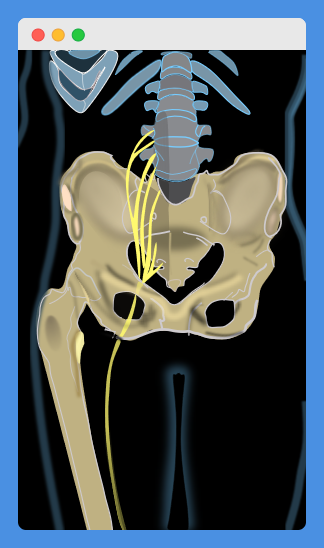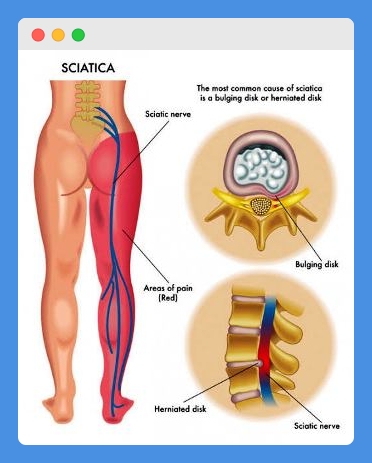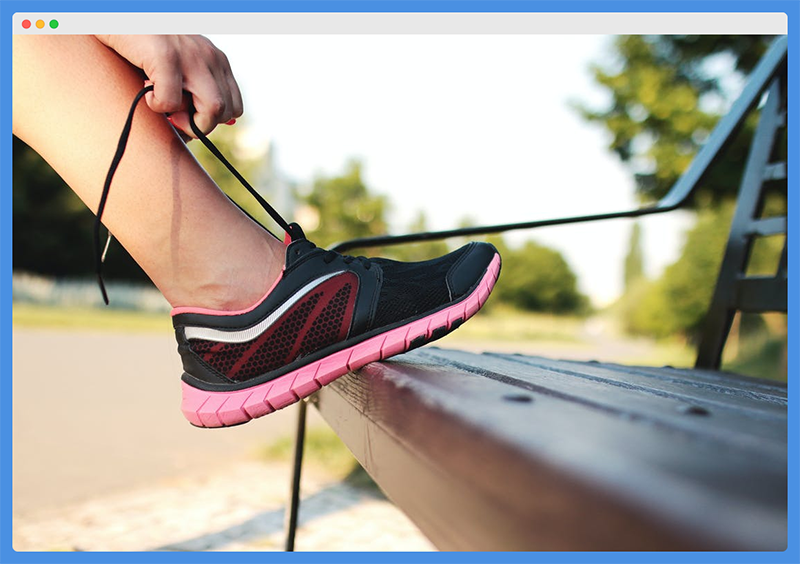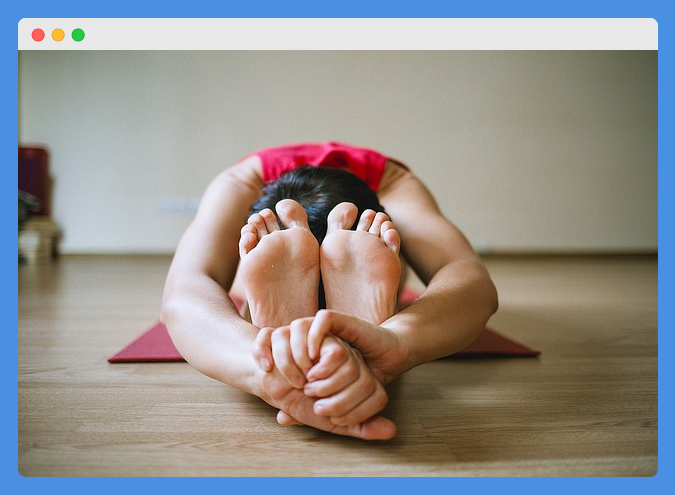
Sciatica pain is an uncomfortable experience some runners deal with. Sometimes, it prevents them from running totally if it is very severe.
But, what is the cause of this sciatica pain? Is it running or something else?
Well, not only runners experience sciatica pain, so it cannot be associated with running alone.
In this post, we will show you if running can cause sciatica pain, what else causes it, how to deal with it, and more. From the genesis, let’s look at the nerve behind all of this.
What Is The Sciatic Nerve?

Though not a very popular nerve, the sciatic nerve is the longest nerve that can be found in the human body.
This nerve can be found in the lower spine, and it is formed from the joining of five nerve roots. These are the 4, L5, S1, S2, and S3 nerve roots.
Being the longest nerve is not an overstatement; the nerve runs from the lower spine to the buttock, the back of the thigh, and reaches the foot sole. It is as long as the lower part of your body.
The role which the sciatic nerve plays is an essential one. It is the nerve that connects the skin and muscles of the lower part of the body to the spinal cord. With this, it carries out sensory and motor functions.
There are two sciatic nerves in the body – one for each lower limb.
What Causes Sciatica Pain?

Sciatica can make you feel pain in the lower part of your back and legs. It is not a disease or illness itself and is mainly a symptom of some other medical condition. Therefore, sciatica pain can be caused by different factors. Some of the major causes are.
Herniated Discs
A herniated disc happens when a disc goes out of place. Discs are made of cartilage and their primary function is to allow flexibility of the spine. With a disc out of place in the spine, flexibility becomes an issue that can result in pain as more pressure is applied to the sciatic nerve.
Lumbar spinal stenosis
This is a situation whereby the spinal cord in the lower part of the back is narrowed. In such a case, the sciatic nerves are compressed and pain is caused.
Spondylolisthesis
This is similar to a herniated disc, but in Spondylolisthesis, the disc slips forward onto the bone that is below it. If the slipping is extreme, it might press on nerves, which causes sciatic pain.
Tumors
If there are tumors inside your spine, there is a high risk of sciatica pain happening. This happens because the tumor tissues compress the sciatic nerve roots.
Injury
Injuries in the lower part of your back can affect the sciatic nerves and result in pain. However, this is more likely in severe injuries and not minor ones.
Cauda equina syndrome
Though this condition is rare, it is severe when it happens. Below the end of the spinal cord is a bundle of nerves known as cauda equina. If they get damaged, it will result in serious sciatic pain in the lower back and legs.
What Are The Risk Factors Of Sciatica Pain?
Most often than not, it is difficult to detect the exact cause of sciatic pain in individuals. Several risk factors also increase the chances of a person experiencing sciatic nerve pain such as:
- Lifestyle: If you are the type of person that sits for long periods, you have a high risk of developing sciatic pain due to inactivity.
- Age: Sciatic pain is more likely to happen to persons in their 30s and 40s than other age groups.
- Work: Engaging in a work that involves carrying heavy objects for a prolonged time, sciatic pain can quickly happen.
- Weight: Too much weight on a person might apply pressure on the spinal cord. So if you’re overweight or pregnant, you have a high risk of developing sciatic pain.
Can Running Cause Sciatica Pain?

Several injuries are often experienced while running. These injuries are mainly linked to muscle, bone, and body tissue. A prevalent one that almost every runner has experienced is nerve pain.
This can happen in any part of the body but often occurs in the lower back. Hence, most runners relate it to sciatic pain.
From the causes of sciatica pain listed above, running is not one of them, but sciatica pain is somewhat related to running in some cases. One of the risk factors of experiencing sciatica pain is having an inactive lifestyle and another is being overweight.
For very active runners, it is rare for them to suffer from sciatica pain due to inactivity. The cause must be secondary. People who don’t run too often might experience sciatica pain whenever they hit the track.
You hardly hear athletes who engage in sports that require running regularly to complain about experiencing sciatica pain. If you do running workouts at home, and your workout routine is not very consistent, sciatica pain may occur when you run for long.
When you run, constant pounding can cause pain, though it is rare. As your legs move, it tightens muscles and also squeezes the disc, which may apply pressure on the sciatic nerves. Medics refer to this as piriformis syndrome.
As mentioned earlier, sciatica pain is just a symptom and not an illness or disease. Therefore just running cannot cause sciatica pain. If you experience sciatica pain while running, it may not be a cause of alarm, as the reason could be inactivity on your part.
However, when it happens more often, you should consult your medical doctor so the root cause of the pain can be determined.
Does Running Further Aggravate Sciatica Pain?
Various factors cause sciatica pain; however, running is not one of them. Nonetheless, running can aggravate sciatica pain if you engage in it while experiencing the pain. As stated before, running can tighten muscles and squeeze tissues with constant motion.
This can increase sciatica pain, which is why it is essential to follow precautions before running if you do experience sciatica pain.
If you do not have any illness or disease of which sciatica pain is a symptom, running won’t cause it. Of course, people do feel several pains during and after running, but not all are linked to the sciatic nerve.
Is Sciatica Common In Runners?

For distance and regular runners, sciatica pain is not common. In a study of 2,000 injured runners, pain from the spine, hamstrings, thigh, and other lower parts of the body constitutes only 8 percent of injuries suffered by runners.
Furthermore, injuries of the lower back, which might include sciatica pain, constitute only 4.4 percent of running injuries.
Sciatica pain is not so common in runners. The fact that running can aggravate the pain doesn’t make it so. In fact, runners can experience sciatica pain due to some medical conditions of risk factors, as previously listed.
How To Run Safely When You Have Sciatica Pain
To run safely when you have sciatica pain, here are some tips you should apply:
Use heat and cold therapy
Before running, you’ll have to relax and warm up the muscles of the lower back. One effective way this can be achieved is via heat therapy. With heat applied to your lower back and close areas, the muscles get loosen, and nerves become more flexible to avoid pain.
Some options you can go for are steamed towels and water bottles. You can apply them for about 10 to 20 minutes before your running session is ideal. Also, you can use heat therapy while running. Heat packs on a back wrap or adhesive wraps can help in this case.
Next is cryotherapy – cold therapy – which is ideal after running. If, after running, you feel sciatica pain, applying ice can help soothe the area and relieve your pain.
Run without shoes

To some runners, running without shoes does help in preventing sciatica pain. This is yet to be approved by experts considering the fallbacks, but it’s still worth trying.
You do not have to start running without shoes immediately. You can start with walking without shoes for some days to get comfortable before you run. Running without shoes leaves your feet unprotected, so you should make use of safe and soft running tracks.
Hard ones will only cause more discomfort.
As stated before, this method lacks expert approval, so if you find it difficult or uncomfortable, there’s every reason to skip it.
Yoga

Yoga has several health benefits. You can build supporting muscles by practicing yoga before running. Exercising 3 times a week for about 5 minutes is enough to effect change. Though it might take weeks before the difference is noticeable, it’ll be worth it.
When you do yoga, less pressure is applied to the sciatic nerve roots, and your body’s flexibility is increased.
With this, muscle strength is increased. Several basic yoga poses can help you achieve this. If, however, your sciatic pain is severe, you can modify the poses to your interest.
It is ideal to work out with an advanced yoga instructor. Some specialize in training people with sciatica pain. There are yoga poses to help deal with sciatica pain based on the cause, and only an advanced instructor can know this.
Change your running pattern

The way or pattern in which you run can aggravate sciatic pain more. If such is the case, you can run safely when you have sciatica pain by changing your running pattern.
You should run with a forward focus, your chest in the lead with your head standing tall. Running while looking up and down might make you feel pain.
Do not pump your arms across yourself or strike the floor with your heels. Try to support your spine while running by engaging your lower-back and abdominal muscles.
It might be difficult making these changes, especially when you’re used to them. You can start with just one in mind, once the achievement is unlocked, you move to the next one.
Best Health Supplements For Sciatica Pain Relief
There are some health supplements you can take for quick relief from sciatica pain. Here are some of the best ones:
This is a supplement with different benefits. It can help each sciatica pain and other sports injuries, make the joints flexible, treat muscle tears and pulls, and boost energy levels. It contains Serrapeptase enzyme, microcrystalline cellulose, and calcium. A capsule three times daily is recommended.
This Vita Sciences supplement was manufactured exclusively for treating sciatica pain. It is advanced formulated with alpha-lipoic acid, vitamin B, magnesium, and amino acid. It can help relieve nerve pain and muscle weakness. No harmful side effects are experienced, and it is to be taken two tablets twice a day.
Here is another supplement you can take for relief and recovery from sciatica pain. Its active ingredients – alpha-lipoic acid, vitamins, magnesium, acetyl l-carnitine – work to improve regeneration and reduce inflammation. It is a fast-acting supplement to be taken two capsules in the afternoon and two capsules at night, with food or after food.
How To Cure Sciatica Pain Permanently

To cure sciatica pain permanently, there are two ways to go – exercises and sciatica pain relievers. If you’re experiencing sciatica pain recently, you should give it a bit of time. The pain will be alleviated within a few weeks.
What you have to do is rest more but still stay active. Inactiveness is a risk factor of sciatic pain that can make the sciatic nerve more irritated and inflamed.
Using hot and cold therapy, as discussed in the previous section, is also ideal for curing sciatica pain permanently.
Ice therapy for about 20 minutes multiple times daily can work for the first three days when you start experiencing the pain. After these three days, you can switch to heat therapy until the pain is gone. Exercises like walking and light stretches can help.
There are some sciatica pain relief products you can also purchase, which include:
This is a hip brace/wrap that can help relieve sciatica pain with its soothing features. It is made with a breathable and lightweight neoprene material, which is comfortable to wear all day as you go about normal activities. When worn, it increases the circulation of blood around the affected area, so recovery is quickened. The ATX Compression Wrap can fit waists up to 42 inches and thighs up to 32 inches. It features adjustable straps, so a total fit is assured.
- ComfiLife Gel Enhanced Seat Cushion
This is a seat cushion for sciatica pain relief that you can use on any seat, including your car seat. It is a durable piece produced using high-density memory foam with a cooling gel layer. The rubbered texture makes it very comfortable to sit on and helps you stay sturdy on it. A zippered cover keeps it clean, and it is lightweight with a built-in handle that makes it portable.
If your sciatica pain has lasted for over a month, it might be a chronic case. For chronic sciatica pain cases, repeated measures need to be taken, which involves medical treatment.
Simple cognitive-behavioral therapy (CBT) might help, but in much more severe cases, your doctor might advise surgery. Surgery would be imminent if other treatments proved unsuccessful. The surgical process will be based on the cause, but, there are two major sciatic pain surgeries, which include:
- Discectomy: a procedure where the herniated disk is partially or entirely removed
- Lumbar laminectomy: a process where the spinal cord at the lower back is widened to reduce nerve pressure
Can Injections Work For Sciatica Pain?

Sciatica pain can be a result of an inflamed sciatica nerve. In such a case, your doctor might administer anti-inflammatory medications to help stop/reduce inflammation.
These medications can be given via injection, and yes, they’ll work if the diagnosis is correct.
Furthermore, doctors also offer pain relievers in the form of injections. There are special epidural injections that provide short term relief to sciatica pain, back pain, etc. Their effects could last for up to 3 months.
Bottom Line
Finally, we have answered the fundamental question – can running cause sciatica pain?
Sciatica pain is a symptom of some other medical complication, so it’ll be wrong to say running can cause it. Running might aggravate the sciatica pain due to the swift movements involved.
Acute sciatica pain cases are not much of a worry and can be eliminated by simple self-care measures.
Hence, you should consult your doctor once you start experiencing sciatica pain. Once a diagnosis is made, subsequent treatment will be administered.
Likewise, you can apply any of the earlier mentioned tips and products for quick relief from the sciatica pain.
Enjoyed Can Running Cause Sciatica Pain? Share it with your friends so they too can follow the MyBodyExpert journey.
Share on Pinterest


Diana Paul is a certified nutritionist who writes for leading health blogs. She is a master herbalist, yoga teacher, forager, and wild-crafting writer She is focused on helping people transform life blocks to opportunities. Based in NYC, she often holds health seminars and lectures.




